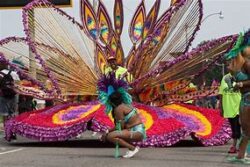On the first Saturday in August back in 1967, Caribana was held for the first time in Toronto, Canada. It was all part of Canada’s Centenial celebrations and in commemoration of the abolition of slavery throughout the British Empire in 1834. This event is said to be initially inspired by Trinidad’s pre-Lenten carnival. Toronto’s three week festival of the arts brings together a wide range of indigenous songs, instruments, music, dances, masqueraders, and a variety of foods from all regions of the Caribbean. Since the 1980’s, the festival has taken on a multicultural dimension; Groups from South and Central America, Africa, The Bahamas, Haiti and elsewhere in Canada now participate. There is never a shortage of activities to partake in as this festival includes: “Calypso tents(shows), jump ups(dances), fetes(parties), mas(masquerade competitions), a junior carnival, pan blockos or ‘blockoramas'(steel band street parties) and talk tents(shows featuring storytellers, comedians and others well versed in oral traditions)”. The main event and highlight of Caribana is always the Grand Parade held on the first Saturday of August. The parade was originally held on Yonge street then on University ave. by 1970. By 1991, the parade commenced on the Canadian National Exhibition(CNE) grounds then onto Lakeshore blvd. west for 3.5 km. “The parade is a spectacular display of costume, sound and color which winds it’s way past dense crowds for several hours”. Since the 1990’s, the size and scale of the parade has diminished significantly. There were over forty bands in the parade back then. By 2016 the number of bands or “floats” has dwindled to a dozen or so. Each band expresses a particular theme; historical, satirical, political or fantasy and is lead by a “King” and “Queen” dressed in the most lavish costumes. The bands compete against each other and are judged based on their costumes, energy and creativity. The music is usually Calypso or Soca originally from Trinidad and Tobago. Other musical genres include; Reggae(from Jamaica), Tassa Drumming(from the East Indian tradition in Trinidad), Cadence(from Haiti and Domenica), Zuk(from St. Lucia), Latin Salsa and recently North American Rap and R&B. Since 2015 the festival’s name has been changed to The Toronto Caribbean Carnival but is still referred to as Caribana by most. Other groups such as The Organisation of Calypso performing Artists(since 1981), holds The Calypso Monarch Competition. The Caribana Arts Group, which owns the Caribana trademark, has influenced the establisment of other festivals which are held at the beginning of August each year as well. These include Irie Fest and Jambana. This three day festival which has grown to extend over three weeks, has also evolved to become “The largest festival of Caribbean culture in North America”. We are all aware of a current pandemic restrictions; so maybe 2022 Toronto will “Jump up” again.





